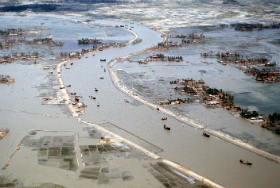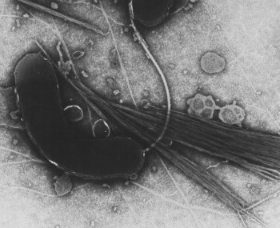Seasonal blooms: what causes periodic coastal cholera proliferation?
Cholera cases total between 3-5 million each year with 100,000-120,000 deaths. It is endemic in Asia and Africa. It causes devastating outbreaks and global pandemics. It is said to have originated in the Bay of Bengal.
The two most recent outbreaks of this gastro-intestinal disease are in Haiti and the Congo River. As of 10 July 2011 388,958 cases had been reported in Haiti, with 5,899 deaths. On 20 July 2011 the World Health Organisation reported 3,896 cases and 256 deaths on the banks of the Congo River in the Democratic Republic of Congo. From 14 to 20 July a total of 181 cases and six deaths were reported in the neighboring Republic of Congo.
Cholera is entirely preventable with comprehensive provision of hygiene, sanitation and drinking water. There has not been an outbreak of cholera in London since such infrastructure was built in the mid-19th century.
The aetiological agent of – or bacteria responsible for – this deadly water-borne disease isVibrio cholerae. It is found in the brackish waters of African and Asian river deltas and estuaries. It is closely associated with copepods, 1-2mm crustaceans that populate the world’s oceans. V. cholerae attaches itself to copepods, this commensal attachment extends the survival of the bacteria.
Copepods feed on phytoplankton – microscopic, free-floating, photosynthesising organisms found in the upper sunlit strata of almost all oceans and bodies of fresh water. Although too small to see with the naked eye, when en masse phytoplankton tinge water green because they are packed to the gunnels with chlorophyll.
Phytoplankton, copepods, V. cholerae, cholera: the consequences of the associations of this little quartet can be framed in a neat hypothesis:
High levels of phytoplankton may lead to high numbers of cholera-containing copepods, increasing the likelihood of cholera epidemics in coastal human populations
There exists interesting correlations between the sea surface temperature and phytoplankton. Many studies have found a negative correlation between surface temperature and abundance of phytoplankton. However in the Bay of Bengal there is a positive relationship which has lead many to assert that warming seas will mean more phytoplankton. This will therefore mean more V. cholerae and therefore more cholera outbreaks.
Those admirable chaps and chapesses at NASA, while not probing Uranus or making history, have developed some sophisticated satellite imaging systems. Researchers from US universities Maryland and Tufts have completed a study, published yesterday, using this space technology to get to the bottom of the puzzling disparity between correlations across the world. They looked for an answer to: why does the Bay of Bengal differ to other delta, riverine and estuarine systems around the world in its association of sea surface temperature and phytoplankton abundance?
One considerable input into the Bay of Bengal is the massive freshwater discharge of the Ganges-Brahmaputra-Meghna river systems; approximately 628 cubic kilometres every year. This river discharge carries nutrients into the Bay causing an increase in phytoplankton. This is the case in other river systems around the world, not just those that empty into the Bay of Bengal.
The American study found that in January to June there was a negative correlation between sea surface temperature and chlorophyll, an indicator of phytoplankton abundance. The rest of the year there was found a positive correlation. When seasonal discharge of freshwater is included in the analysis however, it showed the July to November period of high discharge and had a positive correlation of chlorophyll and sea surface temperature. This would suggest chlorophyll production is influenced by coastal influx of terrestrial nutrients from river discharge. Several areas without freshwater discharge show a negative correlation between sea surface temperature and chlorophyll.
Essentially the influx of nutrients from river discharge influences the production of chlorophyll. These nutrients swept out to sea from river flow must be included in analysis used to predict cholera outbreaks in coastal areas of regions like the Bay of Bengal. The relationship between coastal phytoplankton, sea surface temperature and river discharge must be considered together.
The upshot of this research is two-fold. One is the ramifications this has for predicting the effect of warming as a product of climate change on the proliferation of pathogens. While warmth is an important component of V. cholerae’s habitat it is clear that this is not the prime reason for such blooms of the bacteria in the Bay of Bengal. Secondly, this should open debate on land use in the Ganges-Brahmaputra-Meghna river system and its impact on the outbreaks of cholera in coastal areas. If nutrient discharge has a strong influence ultimately on the proliferation of the V. cholerae pathogen then the chemicals used in farming and industry must be scrutinised. If there is a clear association then greater scrutiny and regulation of those discharging chemicals will be necessary.
Images by the United States Air Force and Dartmouth Electron Microscope Facility
References
![]()
Huq A, Small EB, West PA, Huq MI, Rahman R, & Colwell RR (1983). Ecological relationships between Vibrio cholerae and planktonic crustacean copepods. Applied and environmental microbiology, 45 (1), 275-83 PMID: 6337551
![]()
Jutla, A., Akanda, A., Griffiths, J., Colwell, R., & Islam, S. (2011). Warming Oceans, Phytoplankton, and River Discharge: Implications for Cholera Outbreaks American Journal of Tropical Medicine and Hygiene, 85 (2), 303-308 DOI: 10.4269/ajtmh.2011.11-0181


Really if the temperature goes up then the cholera goes up but it is a problem because if the sea surface temperature goes up phytoplankton goes down. What you find in most of the basin is that the relationship of phytoplankton and sea surface temperature is inverse meaning that when temperature goes up phytoplankton goes down if phytoplankton goes down then cholera goes down..How does this study differ or contradict earlier studies?
dieta
August 27, 2011 at 11:56 pm
Hi, thanks for the comment Dieta. It doesn’t contradict previous studies but the assertion that temperature is the primary factor in the blooms in the Bay of Bengal. The study says rather, the presence of nutrient discharge must be incorporated into studying the blooming cholera. Having received your comment I have reviewed this post and found it not clear. Thank you for drawing attention to this; I hope you’ll forgive, it’s a learning curve this journalism malarky.
Thanks again, EM.
extramural
September 4, 2011 at 5:24 pm